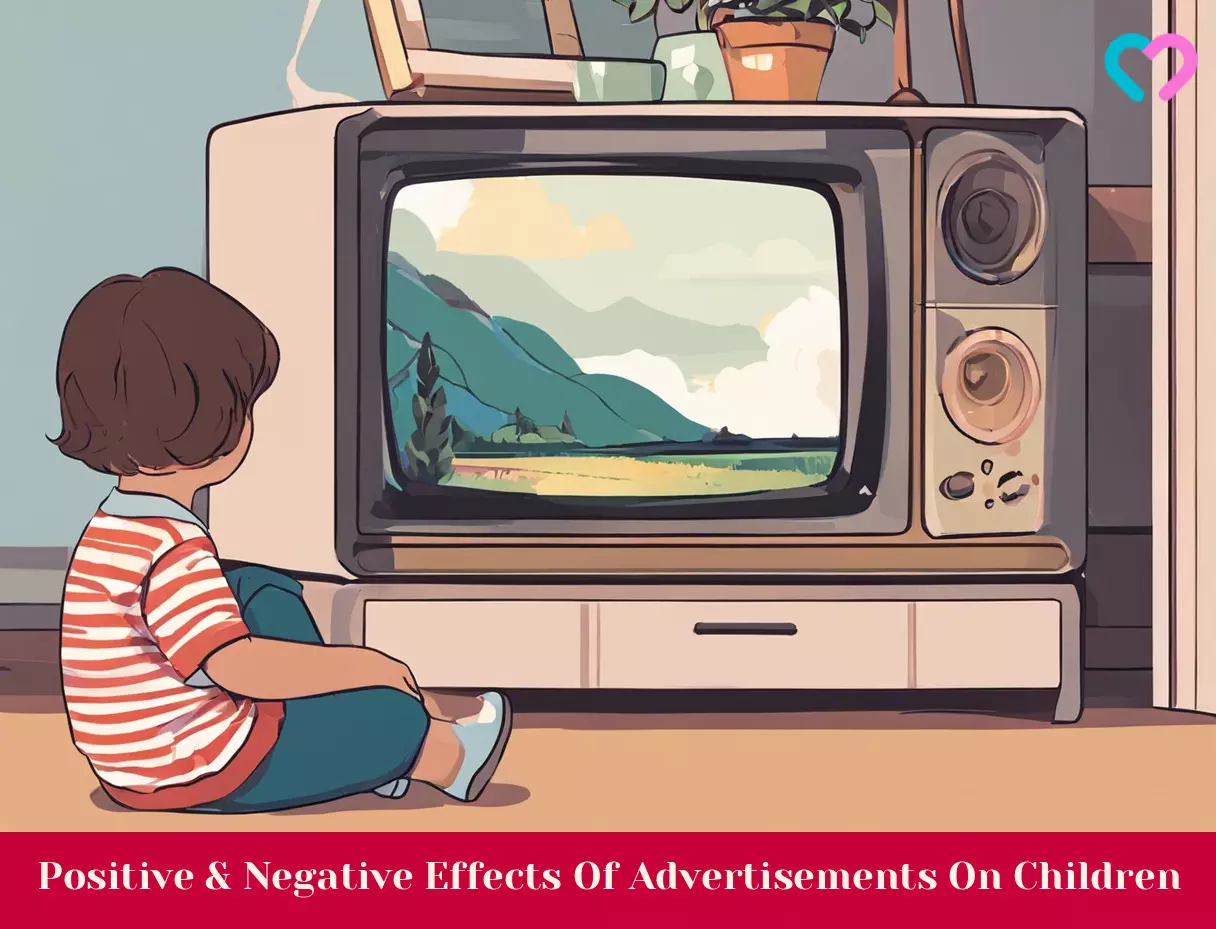
Image: Midjourney/ MomJunction Design Team

Advertisements can have a lasting impact on children. They prompt children to mimic stunts and make them believe in exaggerated product outcomes. If you want to learn about the effects of advertisements on children, this post is for you.
Children remember advertisements as they are constantly broadcast in different forms of media literacy such as on television and other media channels. This may lead to various mental and physical complications. In this post, we talk about how advertisements affect your children and how to deal with them.
Key Pointers
- Advertising can influence children’s behavior efficiently.
- Children may be urged to engage in unhealthy habits, try dangerous stunts, and develop materialistic feelings, among others, by advertising.
- On the other hand, advertisements may also encourage children to exercise, increase knowledge, and spread awareness.
- Parents can limit screen time, introduce educational channels, encourage children to play outside and practice minimalism to counteract negative advertising effects.
Negative Effects Of Advertising On Children
According to the American Psychological Association, an average child is exposed to more than 40,000 TV commercials a year. Studies also suggest that children can recall the content after a single exposure to a commercial and may express a desire to buy the product (1).
Thus, it is imperative to understand the impact of advertising on children. Although the adverse effects of watching advertisements may outweigh the positives, not all advertisements are bad, and some could positively influence children.
First, let us consider the negative effects of advertising on children.
1. Influences their buying decisions
Research suggests that children who watch too much television are likely to demand more toys or other products. Until they are teens, children would not be able to identify advertisements as marketing messages, meaning they could perceive these messages and exaggerations as truths and demand to buy those products. In some cases, these ads can stay with them until they become adults (2).
2. Provokes tobacco and alcohol consumption
Advertisements on alcohol and tobacco can have significant repercussions on children and teens.
Tobacco and alcohol advertising often targets the vulnerability of youth, presenting them as the key to improving self-image and independence, thus provoking children to consume them.
3. Causes eating disorders
Advertisements commonly use young and beautiful women to promote beauty products. It has become a norm to use only fair-skinned women, creating the stereotype that fair skin is beautiful and acceptable in society. Similarly, some ads perpetuate the stereotype that a slim body is healthy and beautiful. Such ads might make children conscious of their appearance and develop a negative body image. These might also lead to eating disorders, such as bulimiaiAn eating disorder characterized by binge eating followed by purging through methods such as vomiting or laxative use or anorexiaiAn eating disorder characterized by extreme weight loss and an intense fear of gaining weight .
Besides the effect on eating, children may indulge in activities that they think could give them what the ads show.
An anonymous blogger shares her insights regarding how ads can have an adverse impact on children on her blog Boycott Ads Towards Kids. She says, ” Barbie was definitely my hottest friend growing up. I loved playing with her, I was even envious of her… a doll, yes, I know. But, I couldn’t help but want her perfectly symmetrical face, enormous blue eyes, legs for days, child’s waist and perfect boobs. I remember stuffing my pink blouse with toilet paper and running around the house with my mom’s heels and lipstick… My envy turned into insecurity and I couldn’t understand why I wasn’t as pretty as Barbie (i).”
4. Develops materialistic feelings
The constant bombardment of advertisements might dictate every moment of your child’s life, and before you realize it, they may begin to define themselves by what they have and what they don’t for who they are. This personality change can create a void in their lives, and they may try to fill it with materialistic things. Materialism becomes a grave issue when it starts affecting your child’s attitude and perceptions about people around them.
5. Beguiles children to try dangerous stunts

Image: IStock
Advertisements often contain false claims or exaggerated content with the intent to attract consumers and grab their interest. Children who are naive may believe them to be true and try to imitate dangerous stunts at home. Although these are accompanied by a statutory messageiA type of cautionary warning for customers to protect them from harm , they are generally overshadowed by the advertisements’ pomp and show.
6. Causes obesity
One of the contributing factors behind childhood obesity is advertising. According to the Rudd Center for Food Policy & Obesity, food companies spend almost $11 billion on TV advertising annually (3). Furthermore, a study conducted in Brazil found that 50% of the advertising directed towards children is related to food, and 80% of those are unhealthy foods high in sugar, fats, and salt (4). This indicates that several advertisements present the wrong notion that consuming a specific drink or fast food makes children successful or happy, trivializing the actual effects of junk food on children’s health.
Under the influence of such ads, children tend to demand to buy more unhealthy foods, leading to obesity.
 Quick fact
Quick fact7. Develops negative feelings
Advertisements usually mock or compare products to show how one product is superior or better than the rest. This commercialism might influence children and start comparing themselves with their peers or believing they are either superior or inferior to the rest. Such behavior may lower their self-confidence or make them feel superior to others.
8. Influences them to resort to impulsive buying
Brands usually create advertisements with the intent of persuasion and manipulation so that the users buy their products. By their branding and repeated portrayals of these ads, children might resort to impulsive buying even when they do not need the product.
9. Influences them to like high-end and expensive things

Image: IStock
Under the influence of advertisements, children might develop a liking for high-end and branded clothes, shoes, and other products. They may even develop a disregard towards other brands that offer products of the same levels of utility but are not featured in ads.
10. Provokes violence and aggressive thoughts
Some advertisements may contain violent and aggressive content geared toward adults. But when children watch these, they might misinterpret them and resort to bullying or demeaning peers or siblings. Such negative behaviors developed in early childhood may stay with them into adulthood.
Positive Effects Of Advertisements On Children
Advertisements can also benefit children in different ways. Here are a few positive effects of advertising on children.
- Advertisements help children gain knowledge about the various new products and innovations in the market.
- Meaningful advertisements that promote hygienic habits, dental hygiene, etc., might help inculcate good habits in children.

Image: IStock
- Advertisements with strong messages, such as helping the elders and saving water, can positively impact children and give them a sense of responsibility.
- Some advertisements spread awareness about road safety, risks of consuming tobacco and alcohol, etc. Such advertisements educate and warn children about the dangers of such activities.
- Some advertisements also help influence children to eat healthily and exercise regularly.

Image: IStock
Although the cons outweigh the pros, you can reverse it by following a systematic approach and limiting your child’s exposure to advertisements. Here is how you can do it.
Understanding Children’s Vulnerability To Advertising
Children are more vulnerable to advertising because their thinking and emotional skills are still developing. Young kids often can’t tell that ads are trying to sell them something. As they get older, they start to understand ads better. But children under six might not know the difference between a TV show and a commercial. How a child reacts to ads also depends on their age, what they like, and what their family and friends think (6). All these things affect how much ads influence children.
What Can Parents Do?
Parents play a key role in negating the harmful effects of advertising on children. It is in their hands to prevent their children’s minds from getting influenced. Advertisements are not limited to television but have permeated the Internet, online games, and even school books and supplies.
A survey found a rising trend in the investment in children’s advertisements on online platforms, indicating an increased viewership. The below graph shows the increasing spending on digital advertising while there is a decrease in non-digital advertising spend in the children’s category.

A rise in digital advertising targeting children
Source: Kids Digital Media Report: Kids digital advertising market will be $1.7bn by 2025; PwC/SuperAwesomeTherefore, parents need to be extra cautious and limit their children’s exposure to advertising.
- The first and foremost thing to do is limit their television viewing time. Keep a cap on their screen time, and do not allow it to go beyond the stipulated time at any cost.
- Encourage them to go out and play with friends for an hour or two daily. This will help divert their minds from the Internet and advertisements.
- Introduce educational channels, such as Discovery and Animal Planet, and encourage them to watch these more often.
- Sit with them while they are watching television. This way, you can explain and educate them to differentiate between good and bad content based on moral and ethics.

Image: IStock
- When a child demands a certain product after watching an advertisement, instead of giving in, you need to explain and show them the ill effects of advertising and how it affects them.
- If your children are entering their teenage years, educate them about the ill effects of consuming alcohol and tobacco.
- Talk to children about the value of things and encourage them to practice minimalism. Once they understand the value of money, they might not get attracted to fallacious advertisementsiA marketing approach that deceives consumers by creating false expectations .
Frequently Asked Questions
1. What is the moral problem with advertising aimed at children?
One of the key problems with advertising to children is that they may be unable to differentiate between exaggeration and truth. They cannot see the bias in the claims that advertisers make. Advertisers are therefore taking advantage of this inability of children to make profits.
2. Should advertising targeted at children be banned?
Banning advertising may not have the desired effect. Instead, enforcing stricter regulations on advertising directed at children and more responsible advertising on the part of the advertisers may yield positive results (7).
3. What are the rules for advertising to children?
Different countries may have different laws pertaining to advertising targeting children. In the US, the Children’s Online Privacy Protection Act (COPPA) gives parents control over what information websites can collect from their kids.
4. What marketing strategies are commonly used to attract children’s attention?
Companies use several techniques to market to children. They create ads with bright colors and cartoon characters that appeal to kids. Catchy songs are often used to make products more memorable. In some cases, products are placed in TV shows, games, or videos that children watch. Additionally, companies may create fun contests or social media challenges to engage younger audiences.
The effects of advertisements on children can be negative and positive. Children are exposed to various advertisements while watching their favorite programs on television, and these ads may influence their desire for products and buying decisions. Some advertisements stereotype skin color to sell skin brightening products, which can leave a lasting impression on the mental well-being of children with dark skin. Ads promoting alcohol, tobacco products, soft drinks, and packed and junk foods may make the children feel they are good and often influence their choices. Some ads can be positive and promote products to gain knowledge and improve health. So, it is your responsibility to explain the details of advertisements to your children so they can differentiate between good and bad. Limit screen time, discuss how ads work, and encourage critical thinking to protect them from negative influences.
Infographic: Pros And Cons Of Advertisement On Children
Advertising information or product is easier in this digital age. Not just on TV, you see commercials on the streets and in web browsers. While adults might not be impacted much, these ads could greatly affect children. Let’s look at the infographic below to learn the good and bad impact of advertisements on children.
Some thing wrong with infographic shortcode. please verify shortcode syntax
Illustration: Positive & Negative Effects Of Advertisements On Children

Image: Stable Diffusion/MomJunction Design Team
Watch this thought-provoking video about the effects that advertising can have on children and their outlook towards life and ways to navigate through this situation.
Personal Experience: Source
MomJunction articles include first-hand experiences to provide you with better insights through real-life narratives. Here are the sources of personal accounts referenced in this article.
i. Advertising causes eating disorders…. whats new?https://hendr118.wordpress.com/2012/10/26/advertising-makes-a-negative-impact-on-women/
References
1. Melissa Dittmann; Protecting children from advertising; American Psychological Association (2004).
2. Mithun Das, Sisir Ghorai, and Sudip Basu; A Study on Effects of TV Advertising on Children; International Journal of Research and Scientific Innovation (2018).
3. Food Marketing > Television Advertising; UConn Rudd Center for Food Policy & Obesity
4. Edgar Rebouças and Projeto Crianca e Consumo; Why Advertising is Bad for Children; Re search of foreign legislation
5. Impact of Advertisement on Children; International Journal of Scientific Development and Research
6. Children’s vulnerability to advertising: an overview of four decades of research (1980s–2020s); International Journal of Advertising
7. Should TV Ads Aimed at Children Be Banned in Australia?Research Gate
Community Experiences
Join the conversation and become a part of our nurturing community! Share your stories, experiences, and insights to connect with fellow parents.
Read full bio of Dr. Maymunah Yusuf Kadiri
Read full bio of Sagari Gongala
Read full bio of Harshita Makvana
Read full bio of Apoorva K


















